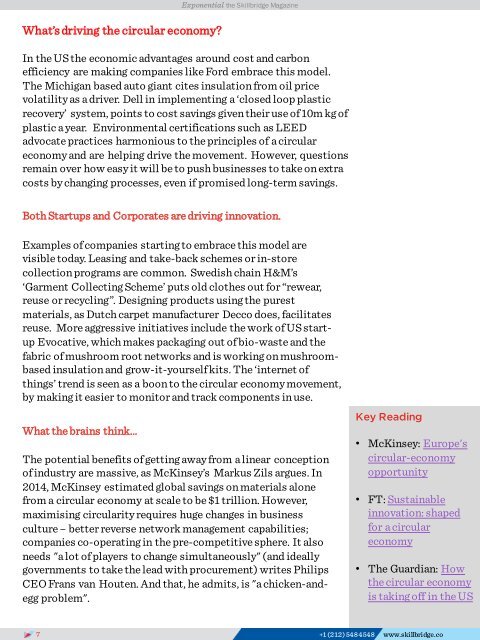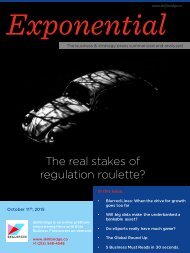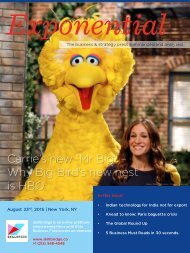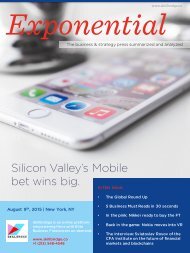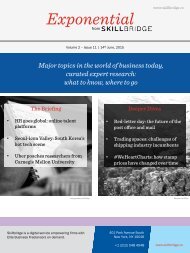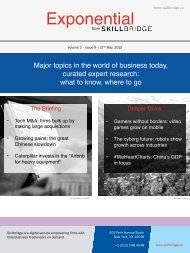Exponential - Sept 6th 2015
In this issue: Getting the circular economy into motion - It’s complicated: Organic brands and Big Brand Food - Tesla Motors’ new model: The Handbag - The Global Round Up - 5 Business Must Reads in 30 seconds.
In this issue: Getting the circular economy into motion - It’s complicated: Organic brands and Big Brand Food - Tesla Motors’ new model: The Handbag - The Global Round Up - 5 Business Must Reads in 30 seconds.
- No tags were found...
Create successful ePaper yourself
Turn your PDF publications into a flip-book with our unique Google optimized e-Paper software.
<strong>Exponential</strong> the Skillbridge Magazine<br />
What’s driving the circular economy?<br />
In the US the economic advantages around cost and carbon<br />
efficiency are making companies like Ford embrace this model.<br />
The Michigan based auto giant cites insulation from oil price<br />
volatility as a driver. Dell in implementing a ‘closed loop plastic<br />
recovery’ system, points to cost savings given their use of 10m kg of<br />
plastic a year. Environmental certifications such as LEED<br />
advocate practices harmonious to the principles of a circular<br />
economy and are helping drive the movement. However, questions<br />
remain over how easy it will be to push businesses to take on extra<br />
costs by changing processes, even if promised long-term savings.<br />
Both Startups and Corporates are driving innovation.<br />
Examples of companies starting to embrace this model are<br />
visible today. Leasing and take-back schemes or in-store<br />
collection programs are common. Swedish chain H&M’s<br />
‘Garment Collecting Scheme’ puts old clothes out for “rewear,<br />
reuse or recycling”. Designing products using the purest<br />
materials, as Dutch carpet manufacturer Decco does, facilitates<br />
reuse. More aggressive initiatives include the work of US startup<br />
Evocative, which makes packaging out of bio-waste and the<br />
fabric of mushroom root networks and is working on mushroombased<br />
insulation and grow-it-yourself kits. The ‘internet of<br />
things’ trend is seen as a boon to the circular economy movement,<br />
by making it easier to monitor and track components in use.<br />
What the brains think…<br />
The potential benefits of getting away from a linear conception<br />
of industry are massive, as McKinsey’s Markus Zils argues. In<br />
2014, McKinsey estimated global savings on materials alone<br />
from a circular economy at scale to be $1 trillion. However,<br />
maximising circularity requires huge changes in business<br />
culture – better reverse network management capabilities;<br />
companies co-operating in the pre-competitive sphere. It also<br />
needs "a lot of players to change simultaneously" (and ideally<br />
governments to take the lead with procurement) writes Philips<br />
CEO Frans van Houten. And that, he admits, is "a chicken-andegg<br />
problem".<br />
Key Reading<br />
• McKinsey: Europe's<br />
circular-economy<br />
opportunity<br />
• FT: Sustainable<br />
innovation: shaped<br />
for a circular<br />
economy<br />
• The Guardian: How<br />
the circular economy<br />
is taking off in the US<br />
7 +1 (212) 548 4548 www.skillbridge.co


